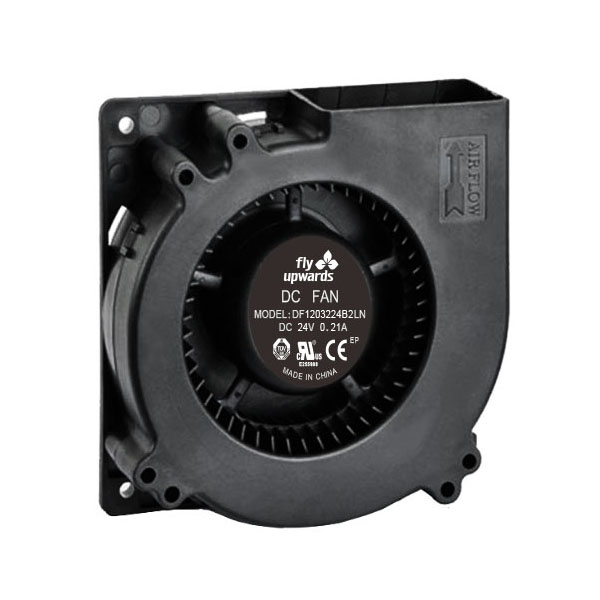Cooling fans: types and functions of cooling fans
2022-05-19
I believe everyone is familiar with the cooling fan. It can be found in computers, water dispensers, refrigerators, air conditioners, air purifiers, cars, etc. It is a very popular cooling device in many industries. In fact, it is just a general term for many types of fans, so what are the specific classifications of cooling fans?
Axial fan
Axial fans are a type of cooling fans, and the impeller of the axial fan pushes the air to flow in the same direction as the shaft. The impeller of an axial fan is similar to a propeller. When it works, the vast majority of gas flow is parallel to the axis, in other words along the axis. Axial fans have the lowest power consumption when the intake air flows free air with zero static pressure. During operation, power consumption increases as the back pressure of the gas flow increases. Axial fans are usually installed in cabinets of electrical equipment and are sometimes integrated with motors. Due to their compact structure, they can save a lot of space and are easy to install, so they are widely used.
Centrifugal fan
When a centrifugal fan is used, the impeller pushes the air to flow in an orientation perpendicular to the axis. The intake air is in the axial direction, and the out air is perpendicular to the axial direction. In most cases, cooling can be achieved by applying an axial fan. However, sometimes a centrifugal cooling fan must be applied if the gas flow requires ninety degrees of rotation or greater air pressure. Strictly speaking, the cooling fan is also a centrifugal cooling fan.
Mixed flow fan
Mixed-flow cooling fans are also called oblique-flow cooling fans. At first glance, mixed-flow cooling fans are no different from axial-flow fans. In fact, the inlet of the mixed-flow cooling fan is along the axis, but the outlet is oriented diagonally between the axis and the vertical axis. Since the impeller and casing of this cooling fan are called conical, the air pressure is higher. Under the same size and other comparative performance, the noise of centrifugal cooling fan is lower than that of axial fan.
Cross flow fan
Tubular airflow creates large-scale airflow and is often used to cool large-scale surfaces of equipment.
The inlet and outlet of the cooling fan are perpendicular to the axis. Cross-flow cooling fans work with relatively long barrel-shaped cooling fan impellers. Barrel fan blades have a larger diameter. Due to the larger diameter, a lower speed can be applied on the basis of ensuring the entire natural ventilation, reducing the noise caused by high-speed operation.

Axial fan
Axial fans are a type of cooling fans, and the impeller of the axial fan pushes the air to flow in the same direction as the shaft. The impeller of an axial fan is similar to a propeller. When it works, the vast majority of gas flow is parallel to the axis, in other words along the axis. Axial fans have the lowest power consumption when the intake air flows free air with zero static pressure. During operation, power consumption increases as the back pressure of the gas flow increases. Axial fans are usually installed in cabinets of electrical equipment and are sometimes integrated with motors. Due to their compact structure, they can save a lot of space and are easy to install, so they are widely used.
Centrifugal fan
When a centrifugal fan is used, the impeller pushes the air to flow in an orientation perpendicular to the axis. The intake air is in the axial direction, and the out air is perpendicular to the axial direction. In most cases, cooling can be achieved by applying an axial fan. However, sometimes a centrifugal cooling fan must be applied if the gas flow requires ninety degrees of rotation or greater air pressure. Strictly speaking, the cooling fan is also a centrifugal cooling fan.
Mixed flow fan
Mixed-flow cooling fans are also called oblique-flow cooling fans. At first glance, mixed-flow cooling fans are no different from axial-flow fans. In fact, the inlet of the mixed-flow cooling fan is along the axis, but the outlet is oriented diagonally between the axis and the vertical axis. Since the impeller and casing of this cooling fan are called conical, the air pressure is higher. Under the same size and other comparative performance, the noise of centrifugal cooling fan is lower than that of axial fan.
Cross flow fan
Tubular airflow creates large-scale airflow and is often used to cool large-scale surfaces of equipment.
The inlet and outlet of the cooling fan are perpendicular to the axis. Cross-flow cooling fans work with relatively long barrel-shaped cooling fan impellers. Barrel fan blades have a larger diameter. Due to the larger diameter, a lower speed can be applied on the basis of ensuring the entire natural ventilation, reducing the noise caused by high-speed operation.

Previous:No News



